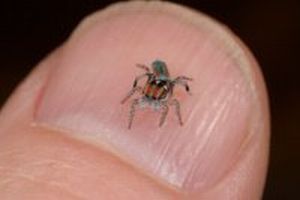|
|
Small Colorful Spider
|
Description
Spiders are chelicerates and therefore arthropods. As arthropods they have: segmented bodies with jointed limbs, all covered in a cuticle made of chitin and proteins; heads that are composed of several segments that fuse during the development of the embryo. Being chelicerates, their bodies consist of two tagmata, sets of segments that serve similar functions: the foremost one, called the cephalothorax or prosoma, is a complete fusion of the segments that in an insect would form two separate tagmata, the head and thorax; the rear tagma is called the abdomen or opisthosoma. In spiders the cephalothorax and abdomen are connected by a small cylindrical section, the pedicel. The pattern of segment fusion that forms chelicerates' heads is unique among arthropods, and what would normally be the first head segment disappears at an early stage of development, so that chelicerates lack the antennae typical of most arthropods. In fact chelicerates' only appendages ahead of the mouth are a pair of chelicerae, and they lack anything that would function directly as "jaws". The first appendages behind the mouth are called pedipalps, and serve different functions within different groups of chelicerates.
Spiders and scorpions are members of one chelicerate group, the arachnids. Scorpions' chelicerae have three sections and are used in feeding. Spiders' chelicerae have two sections and terminate in fangs that are generally venomous, and fold away behind the upper sections while not in use. The upper sections generally have thick "beards" that filter solid lumps out of their food, as spiders can take only liquid food. Scorpions' pedipalps generally form large claws for capturing prey, while those of spiders are fairly small appendages whose bases also act as an extension of the mouth; in addition those of male spiders have enlarged last sections used for sperm transfer.
|
|









